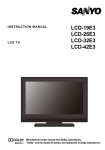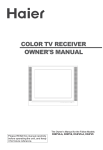Download Planar Systems PX2491W
Transcript
User's Guide PX2491W Make sure to read the Important Precautions before using the product. Keep the User's Guide(CD) in an accessible place for future reference. See the label attached on the product and give the information to Planar's customer service representative should you require assistance. Important Precautions This unit has been engineered and manufactured to ensure your personal safety, however improper use may result in potential electrical shock or fire hazards. In order to allow the proper operation of all safeguards incorporated in this display, observe the following basic rules for its installation, use, and servicing. On Safety Use only the power cord supplied with the unit. If you use another power cord, make sure that it is certified by the applicable national standards when not provided by the supplier. If the power cable is faulty in any way, please contact the manufacturer or the nearest authorized repair service provider for a replacement. The appliance coupler is used as the disconnect device. Please make sure the device is installed near the wall outlet to which it is connected and that the outlet is easily accessible. Operate the display only from a power source indicated in the specifications of this manual or listed on the display. If you are not sure what type of power supply you have in your home, consult with your dealer. Overloaded AC outlets and extension cords are dangerous. So are frayed power cords and broken plugs. They may result in a shock or fire hazard. Contact Planar Customer Service for a replacement cord. As long as this unit is connected to the AC wall outlet, it is not disconnected from the AC power source even if the unit is turned off. Do not Open the Display: There are no user serviceable components inside. There are Dangerous High Voltages inside, even when the power is OFF. Contact Planar if the display is not operating properly. To Avoid Personal Injury : Do not place the display on a sloping shelf unless properly secured. Use only a stand recommended by the manufacturer. Do not drop an object on or apply impact to the product. Do not throw any toys or objects on the product screen. It can cause injury to human, problem to product and damage the display. To Prevent Fire or Hazards: Always turn the display OFF if you leave the room for more than a short period of time. Never leave the display ON when leaving the house. Keep children from dropping or pushing objects into the display's cabinet openings. Some internal parts carry hazardous voltages. Do not add accessories that have not been designed for this display. When the display is to be left unattended for an extended period of time, unplug it from the wall outlet. In the presence of thunder and lightning, never touch the power cord and signal cable because it can be very dangerous. It can cause electric shock. 1 Important Precautions On Installation Do not allow anything to rest upon or roll over the power cord, and do not place the display where the power cord is subject to damage. Do not use this display near water such as near a bathtub, washbowl, kitchen sink, laundry tub, in a wet basement, or near a swimming pool. Displays are provided with ventilation openings in the cabinet to allow the release of heat generated during operation. If these openings are blocked, built-up heat can cause failures which may result in a fire hazard. Therefore, NEVER: Block the bottom ventilation slots by placing the display on a bed, sofa, rug, etc. Place the display in a built-in enclosure unless proper ventilation is provided. Cover the openings with cloth or other material. Place the display near or over a radiator or heat source. Do not rub or strike the Active Matrix LCD with anything hard as this may scratch, mar, or damage the Active Matrix LCD permanently. Do not press the LCD screen with your finger for a long time as this may cause some afterimages. Some dot defects may appear as Red, Green or Blue spots on the screen. However, this will have no impact or effect on the display performance. If possible, use the recommended resolution to obtain the best image quality for your LCD display. If used under any mode except the recommended resolution, some scaled or processed images may appear on the screen. However, this is characteristic of the fixed-resolution LCD panel. Leaving a fixed image on the screen for a long time may cause damage to the screen and cause image burn-in. Make sure to use a screen saver on the product. Burn-in and related problems are not covered by the warranty on this product. Do not shock or scratch the front and sides of the screen with metallic objects. Otherwise, it may cause damage to the screen. Make sure the panel faces forward and hold it with both hands to move. If you drop the product, the damaged product can cause electric shock or fire. Contact Planar for repair. Avoid high temperatures and humidity. 2 Important Precautions On Cleaning Unplug the display before cleaning the face of the display screen. Use a slightly damp (not wet) cloth. Do not use an aerosol directly on the display screen because over-spraying may cause electrical shock. When cleaning the product, unplug the power cord and scrub gently with a soft cloth to prevent scratching. Do not clean with a wet cloth or spray water or other liquids directly onto the product. An electric shock may occur. (Do not use chemicals such as benzene, paint thinners or alcohol) Spray water onto a soft cloth 2 to 4 times, and use it to clean the front frame; wipe in one direction only. Too much moisture may cause staining. On Repacking Do not throw away the carton and packing materials. They make an ideal container in which to transport the unit. When shipping the unit to another location, repack it in its original material. On Disposal Do not dispose of this product with general household waste. Disposal of this product must be carried out in accordance to the regulations of your local authority. 3 Accessories !!! Thank you for selecting Planar products !!! Please make sure the following items are included with your monitor. If any items are missing, contact your reseller. User's Guide/Cards DVI-D Signal Cable Power Cord DVI-I Signal Cable (To set it up, this signal cable may be attached to this product before shipping out.) Monitor Hood (Not included in StereoMirror configuration). USB Cable Cable Holder Calibrator (Spyder3) (optinal accessory) NOTE This accessories may look different from those shown here. User must use shielded signal interface cables (DVI-I cable, DVI-D cable) with ferrite cores to maintain standard compliance for the product. 4 Connecting the Display Before setting up the monitor, ensure that the power to the monitor, the computer system, and other attached devices are turned off. Connecting the stand base or Removing the stand base 1. Place the monitor with its front facing downward on a cushion or soft cloth. 2. Align the hooks on the Stand Body with the matching slots in the Stand Base. 3. Insert the hooks into slots. Hook Stand Body Stand Base Slot WARNING The tape and locking pin may only be removed from those monitors equipped with a standing base when the base is pulled up. Otherwise, you may be injured by the protruding sections of the stand. Handle Product with Care. : When you lift up or move the product, Do Not hold or touch the front part of LCD panel. It will damage the panel. (Please hold the Stand Body or plastic cover of the product.) 5 Connecting the Display 4. Attach the monitor to the Stand Base by turning the screw to the right. Screw : Turn the screw by using the screw handle. 5. Lift and turn the monitor to face towards the front after the connection is made to the female part of the cable you're attaching. 6. Take the screw out by turning to the left to separate the monitor and Stand Base. IMPORTANT This illustration depicts the general model of connection. Your monitor may differ from the items shown in the picture. Do not carry the product upside down holding only the stand base. The product may fall and get damaged or injure your foot. Positioning your display After installation, adjust the angle as shown below. 1. Adjust the position of the panel in various ways for maximum comfort. Tilt Range : -6˚ to 22˚ -6 22 When adjusting the angle of the screen, do not put your finger(s) in between the head of the monitor and the stand body. You can hurt your finger(s). 6 Connecting the Display Swivel Range : 350˚ 350 Height Range : maximum 100.0 mm (3.94 inch) 100.0 mm * Please be sure to remove the Locking pin to adjust the height. WARNING You do not need to replace the Locking pin after it is removed, to adjust its height. ERGONOMIC It is recommended that in order to maintain an ergonomic and comfortable viewing position, the forward tilt angle of the monitor should not exceed 5 degrees. 7 Connecting the Display Using the Pivot function -The pivot function allows you to rotate the screen 90 degrees clockwise. 1. Lift the monitor to its highest height to utilize the Pivot function. 2. Landscape & Portrait : You can rotate the panel 90 o clockwise. Please be cautious and avoid contact between the monitor head and the Stand Base when rotating the screen to access the Pivot function. If the monitor head touches the Stand Base, then the Stand Base could crack. Head section Stand section 3. Be careful with the cables when rotating the screen. 8 Connecting the Display Connecting with the PC/AV equipment 1. Before setting up the monitor, ensure that the power to the monitor, the computer system, and other attached devices is turned off. and power cord of the signal cable. 2. Connect signal input cable 1 2 in order, then tighten the screw A Connect DVI-I Cable B Connect DVI-D Cable C Connect HDMI Cable NOTE This is a simplified representation of the rear view. This rear view represents a general model; your display may differ from the view as shown. The HDMI-DVI cable is not compatible with the DVD player or others. HDMI Headphone Output Headphone /Earphone Connect the signal input cable and tighten it up by turning in the direction of the arrow as shown in the figure. Varies according to model. Wall-outlet type AV equipment (Set-Top Box, DVD, Video,Video Game Console) * HDMI is optimized for AV equipment. * HDMI is not for PC use. Do not connect the commercial Digital-to-Analog converter to the DVI-I cable, because it may not be compatible. 9 Connecting the Display 3. Press the Power Button ( ) on the front panel to turn the power on. When monitor power is turned on, the 'Self Image Setting Function' is executed automatically. (Only for DVI-I analog signal cable input) NOTE ‘ Self Image Setting Function’? This function provides the user with optimal display settings.When the user connects the monitor for the first time, this function automatically adjusts the display to optimal settings for individual input signals. ‘AUTO/SET’ Function? When you encounter problems such as blurry screen, blurred letters, screen flicker or tilted screen while using the device or after changing screen resolution, press the AUTO/SET function button to improve resolution. 10 Connecting the Display To arrange the cables Connect the power cord and the signal cable as shown in the figure and then fix them to the cable holders 1 and 2. 1. 2. Please put the power cord and the signal cable in the cable holder 1. Please insert the cable holder1 into the hole. Cable holder 1 3. Please put the power cord and the signal cable in the cable holder 2. While pressing the bottom of cable holder 2 with one hand, pull the top of it with the other hand as shown in the picture. Pull Press Cable holder 2 NOTE Use the cable holder to organize the cables in order to use the pivot function properly. This picture shows how to organize cables generally and may look different from your product. 11 Connecting the Display Using True Color Finder Program 2 1 Requirements • Windows 2000(Service Pack 4 or higher), XP(Service Pack 2 or higher), Vista, Windows 7 • Macintosh OS X(10.0 to 10.5) 10 1. 2. 11 3. 3 4 5 After installing the monitor hood, insert the CD provided. Click on the [True Color Finder] -> [Installation] icons to install the program. For detailed method on how to use the program, refer to the True Color Finder manual in the provided CD. After executing the "True Color Finder" program, connect the Calibrator(Spyder3) to the monitor and computer respectively. 6 Connecting and Disconnecting the Monitor Hood 12 1. After cross inserting, putting '8' latch into the groove and pushing it towards an arrow direction, please assemble by pressing from number 9 to number 12. Connect the Monitor Hood as shown below. After inserting '1' latch into the groove and pushing it towards an arrow direction, please assemble by pressing from number 2 to number 6. 3 4 5 2 6 2 3 4 5 1 2 13 8 9 10 11 7 8 7 7 9 8 12 4 3 10 10 11 11 12 12 1 2 13 A click will be 13 heard 9 5 6 1 6 2. 7 1 6 3 4 5 (optinal accessory) when the clip engages. To disconnect the monitor hood, follow the steps in the reverse order. 7 12 13 611 54 10 3 8 1 12 2 12 13 11 10 8 10 9 3 2 Connecting the Display 8 12 13 11 10 9 8 12 13 11 10 8 Connecting the Calibrator(Spyder3) (optinal accessory) Connect the Calibrator(Spyder3) to the monitor as shown below. Tilt the monitor to maximum of 16° to the rear to use the Calibrator (Spyder3). 1 2 1 1 2 2 AUDIO OUT AUDIO OUT 1. 16 NOTE Do not put excessive pressure on the monitor hood when fitting. It may damage the hood. Do not put any objects on the hood. With the hood installed, do not shake it or rotate the screen(Pivot). The Calibrator (Spyder3) may not be provided for some models. 13 Connecting the Display Connecting the USB(Universal Serial Bus) Cable You can use the USB port at the back of the monitor to connect peripherals (USB mouse, USB keyboard, etc.) to the monitor, not to the computer. 2 1. 1 Four USB Downstream ports Connect these ports to a mouse, memory stick or USB hard disk. One USB Upstream port Connect this port to the downstream port of a computer, laptop or USB monitor (Your computer or USB monitor must support USB and have USB ports). 2. The monitor’s USB terminal supports USB 2.0 and High Speed cables. 14 Control Panel Functions Front Panel Controls MODE Button Use this button to move to items in COLOR MODE (CUSTOM, sRGB, ADOBE RGB, CALIBRATION, EMULATION, PLNR). For more information, refer to page 20 to 21. MENU Button Use this button to enter or exit the On Screen Display. OSD LOCKED/UNLOCKED This function allows you to lock the current control settings, so that they cannot be inadvertently changed. Press and hold the MENU button for several seconds. The message "OSD LOCKED" should appear. You can unlock the OSD controls at any time by pushing the MENU button for several seconds. The message "OSD UNLOCKED" should appear. 15 Control Panel Functions Buttons Use these buttons to select or adjust functions in the On Screen Display. To adjust the headphone/earphone volume. Press the AUTO/SET button to MUTE ON and press it once again to MUTE OFF. (Only for HDMI input) MUTE OFF Use the buttons to adjust the volume. MUTE ON (SOURCE Hot key) AUTO/SET Button When two or more input signals are connected, you can select the input signal (DVI-I/DVI-D/HDMI) you want. When only one signal is connected, it is automatically detected. The default input signal is DVI-I (analog). Use this button to enter a selection in the On Screen Display. AUTO IMAGE ADJUSTMENT When adjusting your display settings, always press the AUTO/SET button before entering the On Screen Display(OSD). (Only for DVI-I analog signal cable input) This will automatically adjust your display image to the ideal settings for the current screen resolution size (display mode). The best display mode is 1920 x 1200 Power Button Use this button to turn the display on or off. Power Indicator The power indicator stays red if the display is running properly (On Mode). If the display is in Sleep Mode (Energy Saving), the power indicator is blinking red. 16 On Screen Display (OSD) Control Adjustment Screen Adjustment Making adjustments to the image size, position and operating parameters of the display is quick and easy with the On Screen Display Control system. A short example is given below to familiarize you with the use of the controls. The following section is an outline of the available adjustments and selections you can make using the OSD. To make adjustments in the On Screen Display, follow these steps: Pops up the menu screen Move where you want to adjust Select a menu icon Adjust the status Exit from the menu screen. 1 Press the MENU Button, then the main menu of the OSD appears. 2 To access a control, use the or Buttons. When the icon you want becomes highlighted, press the AUTO/SET Button. 3 Use the / Buttons to adjust the image to the desired level. Use the AUTO/SET Button to select other sub-menu items. 4 Press the MENU Button once to return to the main menu to select another function. Press the MENU Button twice to exit from the OSD. 17 On Screen Display(OSD) Selection and Adjustment The following table indicates all the On Screen Display control, adjustment, and setting menus. DVI-I(A) : DVI-I(Analog) signal DVI-I(D) : DVI-I(Digital) signal DVI-D Main menu COLOR MODE Sub-menu : DVI-D(Digital) signal Supported signals Description CUSTOM DVI-I(A) DVI-I(D) DVI-D HDMI(Y) HDMI(R) The default mode that adjusts the overall range of colors of the RGB LED panel. sRGB DVI-I(A) DVI-I(D) DVI-D HDMI(R) Adjusts colors based on sRGB. ADOBE RGB DVI-I(A) DVI-I(D) DVI-D HDMI(R) Adjusts colors based on ADOBE RGB. CALIBRATION DVI-I(A) Adjusts Color features by controlling the Brightness, WhitePoint and Gamma values through the color management system (CMS). DVI-I(D) DVI-D EMULATION DVI-I(A) DVI-I(D) DVI-D Adjusts Color features by controlling the Brightness, WhitePoint , RGB Color Gamut and Gamma values through the color management system (CMS). DVI-I(A) DVI-I(D) DVI-D HDMI(Y) HDMI(R) Color features are pre-set for 255 monotonic gray levels. BRIGHTNESS CONTRAST GAMMA DVI-I(A) DVI-I(D) DVI-D HDMI(Y) HDMI(R) Standard image settings. BLACK LEVEL HDMI(Y) HDMI(R) WHITE BALANCE DVI-I(A) PLNR PICTURE HDMI(Y) : HDMI (YUV) signal HDMI(R) : HDMI (RGB) signal 18 On Screen Display(OSD) Selection and Adjustment COLOR COLOR TEMP (PRESET) (USER) 5000K 6500K 7200K 8200K 9300K RED GREEN BLUE HUE SATURATION SIX COLOR (RED/GREEN/ BLUE/CYAN/ MAGENTA/ YELLOW) DVI-I(A) DVI-I(D) DVI-D HDMI(Y) HDMI(R) Color temperature adjustments COLOR RESET TRACKING HORIZONTAL DVI-I(A) VERTICAL CLOCK DVI-I(A) PHASE SETUP SHARPNESS DVI-I(A) DVI-I(D) DVI-D HDMI(Y) HDMI(R) HORIZONTAL MIRRORING DVI-I(A) DVI-I(D) DVI-D HDMI(Y) HDMI(R) LANGUAGE DVI-I(A) DVI-I(D) DVI-D HDMI(Y) HDMI(R) OSD POSITION (HORIZONTAL / VERTICAL) Adjusts the position of the screen Adjusts the clarity and stability of the screen To adjust to set the image mirroring(horizontal inversion). Additional settings HDMI(Y) HDMI(R) OVERSCAN ARC DVI-I(A) DVI-I(D) DVI-D HDMI(Y) HDMI(R) RTC POWER INDICATOR FACTORY RESET NOTE The order of icons may differ depending on the model (18 to 27). 19 On Screen Display(OSD) Selection and Adjustment The OSD screen will appear when you press the MODE button on the front of the monitor. DVI Input HDMI(RGB) Input HDMI(YUV) Input *When HDMI(RGB) is inputted, CUSTOM, sRGB, ADOBE RGB and PLNR mode are supported. *When HDMI(YUV) is inputted, CUSTOM and PLNR mode are supported. MENU : Exit : Move AUTO/SET : Select Main menu CUSTOM Description The default mode that adjusts the overall range of colors of the RGB LED panel. You can adjust the color functions of the main menu. * In modes other than CUSTOM mode, you cannot adjust the PICTRUE (CONTRAST,GAMMA) and COLOR functions of the main menu. sRGB Color features are set for sRGB specification. Color Temperature, Brightness, Gamma and x and y coordinates of RGBCMY are adjusted based on the sRGB specification. 20 On Screen Display(OSD) Selection and Adjustment Main menu ADOBE RGB Description Color features are set for Adobe RGB specification. Color Temperature, Brightness, Gamma and x and y coordinates of RGBCMY are adjusted based on the Adobe RGB specification. CALIBRATION Adjusts Color features by controlling the Brightness, WhitePoint and Gamma values through the color management system (CMS). * This function is available only after 'True Color Finder' is installed on the computer and calibration has been performed with the calibrator. EMULATION Adjusts Color features by controlling the Brightness, WhitePoint , RGB Color Gamut and Gamma values through the color management system (CMS). * This function is available only after 'True Color Finder' is installed on the computer and calibration has been performed with the calibrator. PLNR Color features are preset for 255 monotonic levels of gray. 21 On Screen Display(OSD) Selection and Adjustment You were introduced to the procedure of selecting and adjusting an item using the OSD system. Listed below are the icons, icon names, and icon descriptions of the all items shown on the Menu. Press the MENU Button, then the main menu of the OSD appears. Main Menu MENU : Exit : Adjust (Decrease/Increase) SET : Enter : Select another sub-menu Button Tip : Restart to select sub-menu Menu Name Submenus Icons NOTE OSD (On Screen Display) menu languages on the monitor may differ from the manual. 22 On Screen Display(OSD) Selection and Adjustment Main menu Sub menu Description PICTURE BRIGHTNESS To adjust the brightness of the screen. CONTRAST To adjust the contrast of the screen. GAMMA Set your own gamma value. : 1.8 to 2.4 On the monitor, high gamma values display whitish images and low gamma values display blackish images. HDMI Input BLACK LEVEL You can set the offset level. If the black level value becomes higher, the screen grows brighter. If the value becomes lower, the screen grows darker. (Only for HDMI input) MENU : Exit : Decrease : Increase SET : Select another sub-menu * Offset? As the criteria for video signal, it is the darkest screen the monitor can show. WHITE BALANCE If the output of the video card is different than the required specifications, the color level may deteriorate due to video signal distortion. Using this function, the signal level is adjusted to fit into the standard output level of the video card in order to provide the optimal image. Activate this function when white and black colors are present in the screen. (Only for DVI-I analog input) 23 On Screen Display(OSD) Selection and Adjustment Main menu Sub menu Description COLOR PRESET Mode USER Mode Use the COLOR TEMP Select either PRESET or USER to adjust the screen color. PRESET Select the preset color temperature. 5000K to 6500K: Yellow screen color. 6500K to 7200K: Red screen color. 8200K to 9300K: Blue screen color. USER A user can create screen color by adjusting RED, GREEN and BLUE. Set your own red color levels. RED GREEN BLUE HUE Adjusts the screen hue. SATURATION Adjusts the color sharpness on the screen. Lower values make the color sharpness weaker and colors lighter while higher values make the color sharpness stronger and colors darker. SIX COLOR Sets and stores the hue and saturation for six colors(RED/GREEN/BLUE/CYA N/MAGENTA/YELLOW) to satisfy the color requirements of a user. COLOR RESET Resets the color settings to the factory default settings for the current input device. button to go to sub-menu. MENU : Exit : Decrease : Increase SET : Select another sub-menu 24 On Screen Display(OSD) Selection and Adjustment Main menu Sub menu Description TRACKING HORIZONTAL To move image left and right. MENU : Exit : Decrease : Increase SET : Select another sub-menu VERTICAL To move image up and down. CLOCK To minimize any vertical bars or stripes visible on the screen background. The horizontal screen size will also change. PHASE To adjust the focus of the display. This item allows you to remove any horizontal noise and clear or sharpen the image of characters. SHARPNESS To adjust the clearness of the screen. HORIZONTAL MIRRORING Adjust to activate or disable mirroring(horizontal inversion). 25 On Screen Display(OSD) Selection and Adjustment Main menu Sub menu Description SETUP DVI Input MENU : Exit : Adjust : Adjust SET : Select another sub-menu LANGUAGE To choose the language in which the control names are displayed. OSD POSITION To adjust position of the OSD window on the screen. OVERSCAN Removes noise that may occur at the edges of an image when HDMI is connected to an external device. When ON is selected, the image size is reduced to prevent noise. When OFF is selected, the original image size is maintained regardless of noise. (Only for HDMI input) ARC Sets the screen size. - FULL: Fits the screen to the panel size. - ORIGINAL: Adjusts the aspect ratio automatically depending on input image signal. -1:1: Changes the aspect ratio to 1:1 depending on input image signal. FULL ORIGINAL 1:1 * ARC is disabled when the input signal has the recommended resolution of 1920 x 1200. 26 On Screen Display(OSD) Selection and Adjustment Main menu Sub menu Description SETUP HDMI Input MENU : Exit : Adjust : Adjust SET : Select another sub-menu RTC If you set ON, you enable the Response Time Control function and reduce the afterimage of the screen. If you set OFF, you disenable the Response Time Control function and operate at panel response time. POWER INDICATOR Use this function to set the power indicator on the front side of the monitor to ON or OFF. If you set OFF, it will go off. If you set ON at any time, the power indicator will automatically be turned on. FACTORY RESET Restore all factory default settings except 'LANGUAGE' and the color settings of 'CALIBRATION', 'EMULATION' mode. Press the , buttons to reset immediately. NOTE If this does not improve the screen image, restore the factory default settings. If necessary, execute the white balance function again. The White Balance function is available only when the input signal is DVI-I (Analog). 27 Troubleshooting Check the following before calling for service. No image appears ● Is the power cord of the • Check and see if the power cord is connected properly to the power outlet. display connected? ● Is the power indicator light on? • Press the Power button. ● Is the power on and the • Adjust the brightness and the contrast. power indicator red? ● Is the power indicator blinking? • If the display is in power saving mode, try moving the mouse or pressing any key on the keyboard to bring up the screen. • Try to turn on the PC. ● Do you see an "OUT OF • This message appears when the signal from the PC (video card) is out of horizontal or vertical RANGE" message on frequency range of the display. See the the screen? 'Specifications' section of this manual and configure your display again. ● Do you see a "CHECK SIGNAL CABLE" message on the screen? • This message appears when the signal cable between your PC and your display is not connected. Check the signal cable and try again. Do you see a "OSD LOCKED" message on the screen? ● Do you see “OSD LOCKED” when you push MENU button? • You can secure the current control settings, so that they cannot be inadvertently changed. You can unlock the OSD controls at any time by pushing the MENU button for several seconds: the message “OSD UNLOCKED” will appear. 28 Troubleshooting Display image is incorrect ● Display Position is incorrect. • Press the AUTO/SET button to automatically adjust your display image to the ideal setting. If the results are unsatisfactory, adjust the image position using the H position and V position icon in the on screen display. ● On the screen background, vertical bars or stripes are visible. • Press the AUTO/SET button to automatically adjust your display image to the ideal setting. If the results are unsatisfactory, decrease the vertical bars or stripes using the CLOCK icon in the on screen display. ● Any horizontal noise appearing in any image or characters are not clearly portrayed. • Press the AUTO/SET button to automatically adjust your display image to the ideal setting. If the results are unsatisfactory, decrease the horizontal bars using the PHASE icon in the on screen display. • Check Control Panel --> Display --> Settings and adjust the display to the recommended resolution or adjust the display image to the ideal setting. Set the color setting higher than 24 bits (true color). IMPORTANT Check Control Panel --> Display --> Settings and see if the frequency or the resolution were changed. If yes, readjust the video card to the recommend resolution. If the recommended resolution (optimal resolution) is not selected, letters may be blurred and the screen may be dimmed, truncated or biased. Make sure to select the recommend resolution. The setting method can differ by computer and O/S (Operation System), and resolution mentioned above may not be supported by the video card performance. In this case, please contact Planar. 29 Troubleshooting Display image is incorrect ● The screen color is mono or abnormal. • Check if the signal cable is properly connected and use a screwdriver to fasten if necessary. • Make sure the video card is properly inserted in the slot. • Set the color setting higher than 24 bits (true color) at Control Panel - Settings. ● The screen blinks. • Check if the screen is set to interlace mode and if yes, change it to the recommend resolution. Do you see an "Unrecognized monitor, Plug&Play (VESA DDC) monitor found" message? ● Have you installed the display driver? • Be sure to install the display driver from the display driver CD (or diskette) that comes with your display. Or, you can also download the driver from our web site: http://www.planar.com. • Make sure to check if the video card supports Plug&Play function. The Audio function is not working ● Picture OK & No sound. • Check whether volume is "0". • Check sound muted. • HDMI cable installed properly. • Head phone cable installed properly. • Check sound format. Not supply to compressed sound format. 30 Specifications Display 60.96 cm (24.0 inch) Flat Panel Active matrix-TFT LCD Anti-Glare coating Visible diagonal size : 60.96 cm 0.270 mm x 0.270 mm (Pixel Pitch) Sync Input Horizontal Freq. Vertical Freq. Input Form 30 kHz to 83 kHz (Automatic) 56 Hz to 75 Hz (Automatic) Separate Sync. Digital Video Input Signal Input DVI-I Connector (Analog, Digital) DVI-D Connector (Digital), HDMI Connector(Video) RGB Analog, Digital, HDMI Input Form Resolution Max Recommend VESA 1920 x 1200 @ 60 Hz DVI-I/DVI-D Input : VESA 1920 x 1200 @ 60 Hz HDMI(Video) Input : VESA 1920 x 1080 @ 60 Hz Plug&Play DDC 2B Power Consumption On Mode Sleep Mode Off Mode Dimensions & Weight With Stand Width 56.01 cm (22.05 inch) Height 44.66 cm (17.58 inch) (Min.) 54.66 cm (21.52 inch) (Max.) Depth 27.02 cm (10.64 inch) : ≤ ≤ 64 W (Typ.) 2 W (DVI-I Input) 1W Weight(excl. packing) Without Stand Width 56.01 cm (22.05 inch) Height 37.21 cm (14.65 inch) Depth 9.55 cm ( 3.76 inch) 9.6 kg (21.16 lb) 10.5 kg (23.15 lb)(With Hood) Range Tilt Swivel Height Power Input AC 100-240 V~ 50 / 60 Hz 0.9 A -6˚ to 22˚ 350˚ 100 mm ( 3.94 inch) 31 Specifications Environmental Conditions Operating Conditions Temperature 10 ˚C to 35 ˚C Humidity 10 % to 80 % non-Condensing Storage Conditions Temperature -20 ˚C to 60 ˚C Humidity 5 % to 90 % non-Condensing Stand Base Attached ( Power cord Wall-outlet type USB Standard USB 2.0, Self-Power Data Rate Max 480 Mbps Power Consumption Max 2.5 W x 4 ), Detached ( O ) NOTE Information in this document is subject to change without notice. 32 Specifications Preset Modes (Resolution) - DVI INPUT Display Modes (Resolution) 1 2 3 4 5 6 7 8 9 10 11 12 13 14 15 16 *17 640 x 480 640 x 480 720 x 480 720 x 400 800 x 600 800 x 600 1024 x 768 1024 x 768 1152 x 864 1280 x 768 1280 x 768 1280 x 1024 1280 x 1024 1600 x 1200 1680 x 1050 1680 x 1050 1920 x 1200 VGA VESA VESA VGA VESA VESA VESA VESA VESA VESA VESA VESA VESA VESA VESA VESA VESA Horizontal Freq. (kHz) 31.469 37.500 35.162 31.500 37.879 46.875 48.363 60.023 67.500 47.776 60.289 63.981 79.976 75.000 64.674 65.290 74.038 Vertical Freq. (Hz) 59.940 75.000 59.901 70.156 60.317 75.000 60.004 75.029 75.000 59.870 74.893 60.020 75.025 60.000 59.883 60.454 59.950 *Recommend Mode HDMI VIDEO INPUT Display Modes (Resolution) 1 2 3 4 5 6 7 8 Horizontal Freq. (kHz) Vertical Freq. (Hz) 31.50 31.25 37.50 45.00 28.12 33.75 56.25 67.50 60.00 50.00 50.00 60.00 50.00 60.00 50.00 60.00 480p 576p 720p 720p 1080i 1080i 1080p 1080p Indicator MODE On Mode Sleep Mode Off Mode LED Color Red Red Blinking Off 33 Installing the Wall mount plate This monitor satisfies the specifications of the Wall mount plate or the interchange device. 1. After moving the product to face downward, make sure to place it on a soft cloth or a cushion to avoid surface damage. 2. Separate the head and the stand with the use of a screwdriver. 3. Install the Wall mount plate. Wall mount plate (Separate purchase) - Be sure to use screws and a wall mount that meet VESA standards. - Using screws longer than those recommended might damage the product. - Using screws that do not meet VESA standards might either damage the product or result in it coming away from the wall.We will not be held responsible for any damage resulting from failure to follow these instructions. Kensington Security Slot Connected to a locking cable that can be purchased separately at most computer stores. Wall Mount pad < Screw Mounting Interface Dimension > Hole spacing : 100 mm x 100 mm NOTE VESA compatible only with respect to screw mounting interface dimensions and mounting screw specifications Please use VESA standard as below. * 784.8 mm and under (30.9 inch) - Wall Mount Pad Thickness : 2.6 mm - Screw : 4.0 mm x Pitch 0.7 mm x Length 10 mm * 787.4 mm and above (31.0 inch) - Please use VESA standard wall mount pad and screws. 34 Planar System's Inc. 1195 NW Compton Drive Beaverton, OR 97006 (503)748-1195 (866)-Planar1 (752-6271) [email protected] 2010, Planar Systems, Inc. Planar is a registered trademark of Planar Systems, Inc. All other trademarks are property of their respective owners. Technical information in this document is subject to change without notice. Please consult your account manager for up to date and/or custom configurations.















































